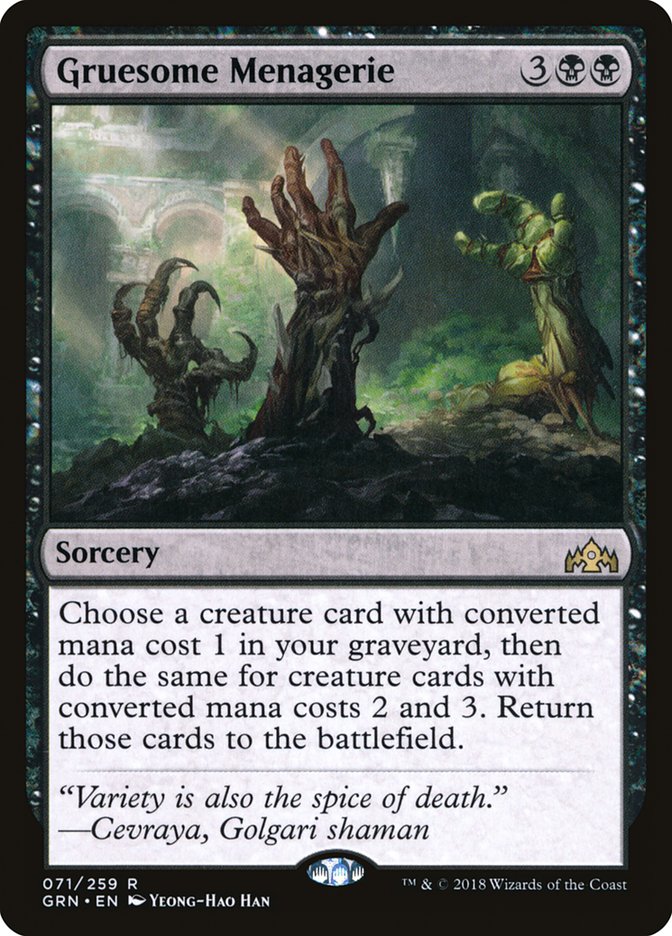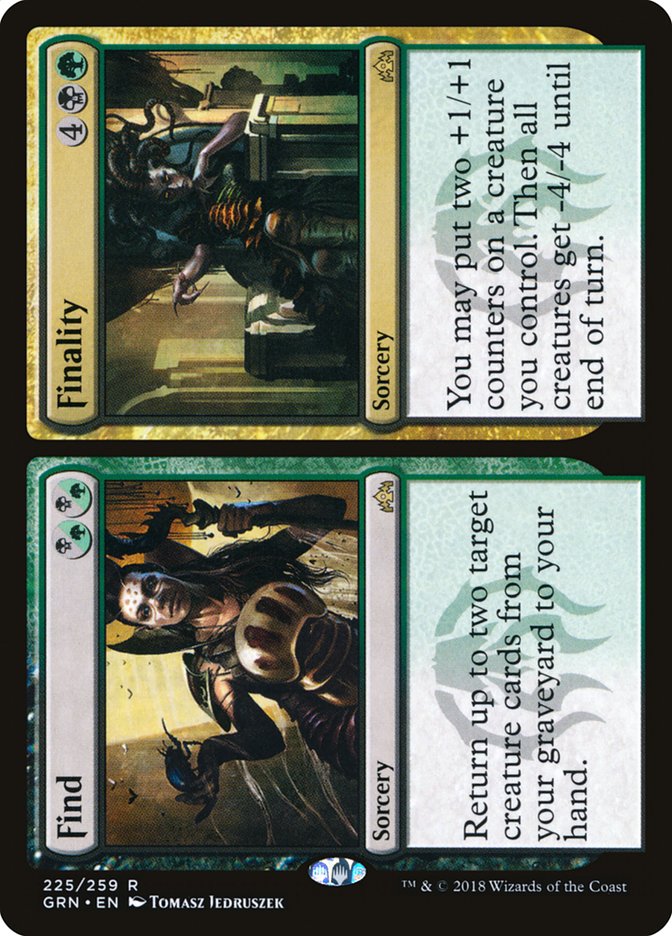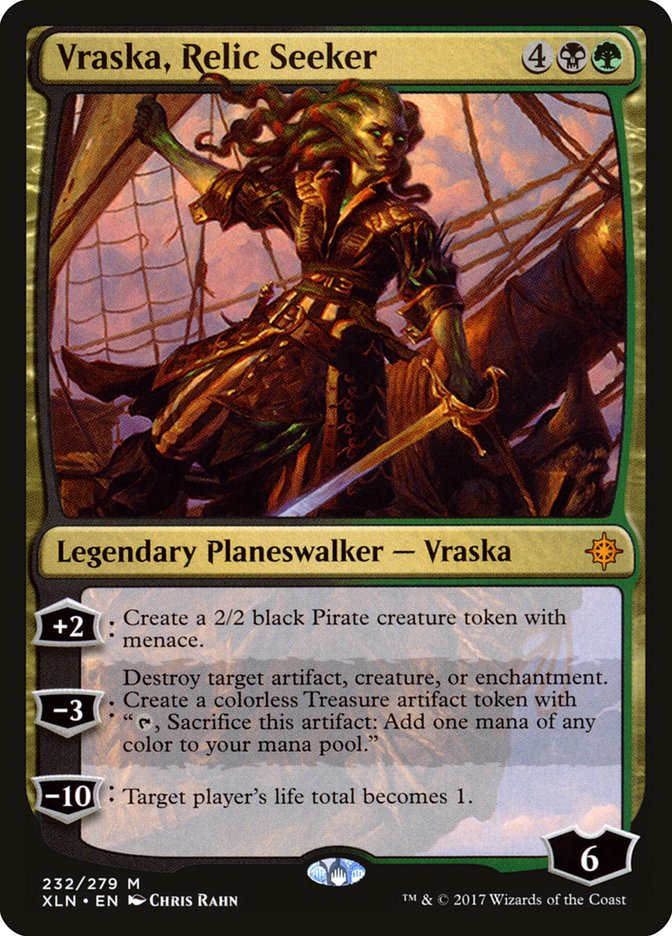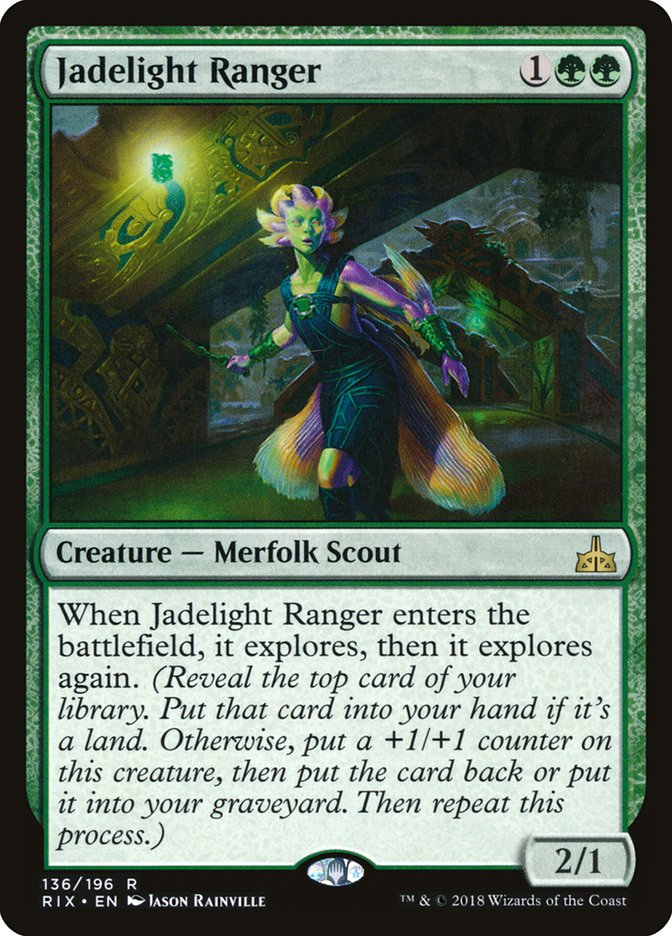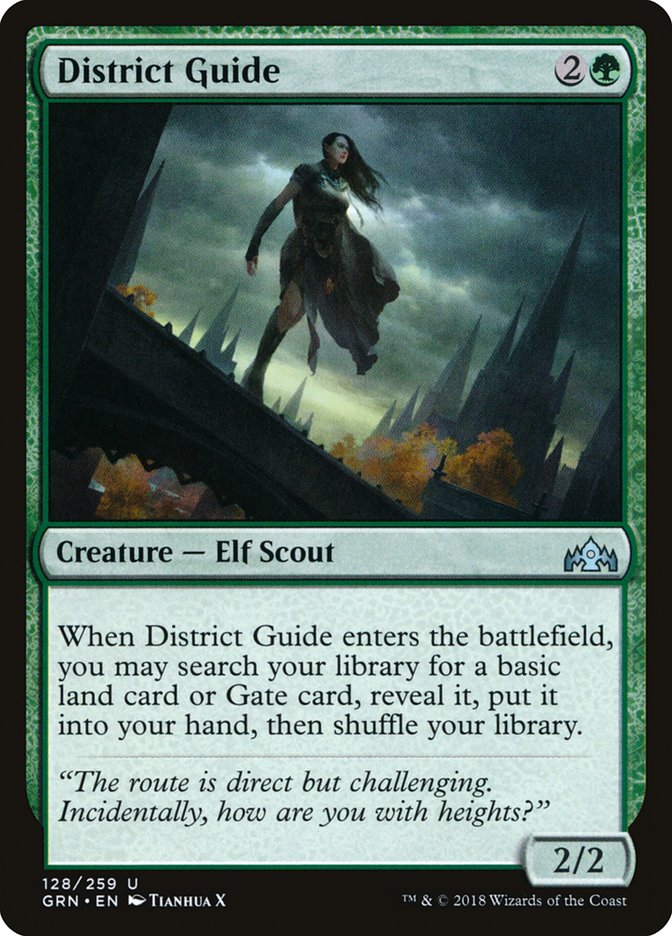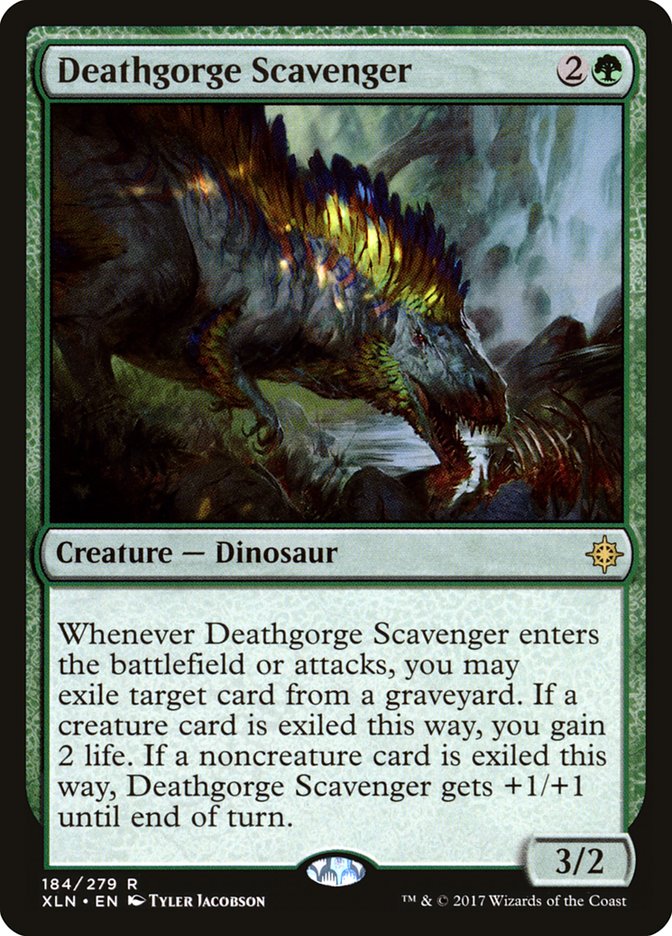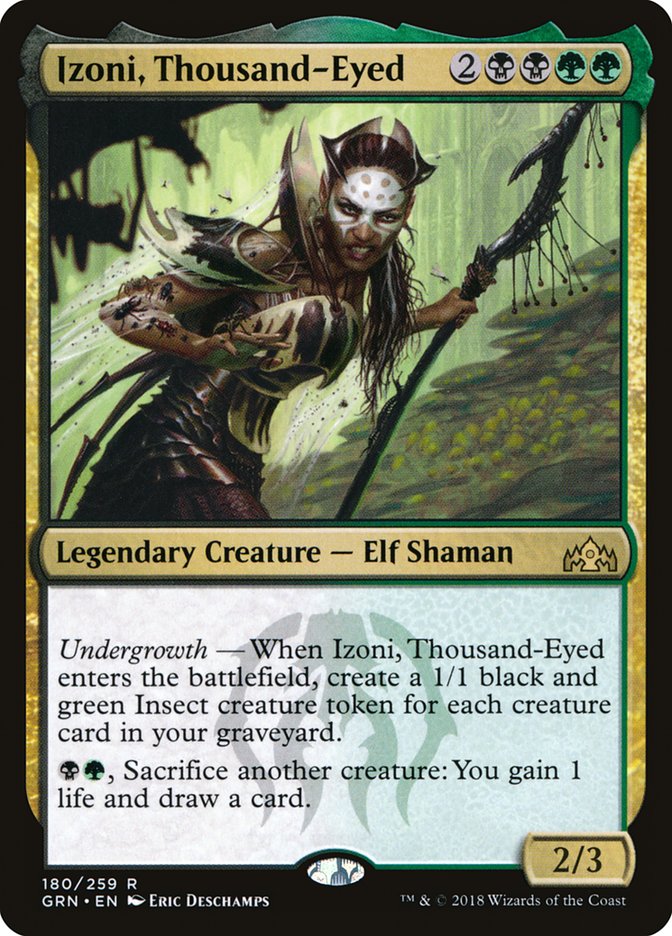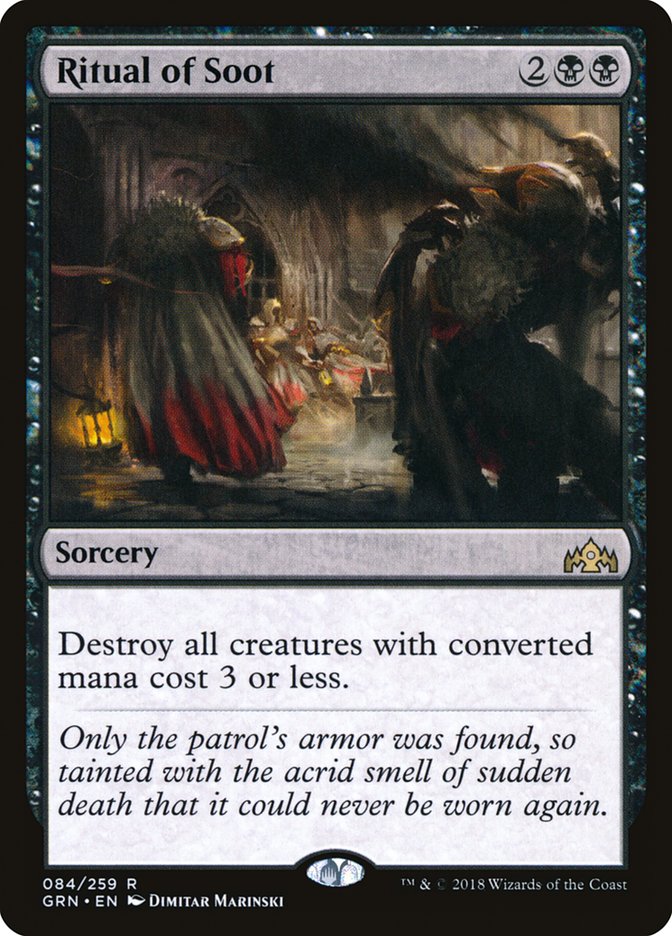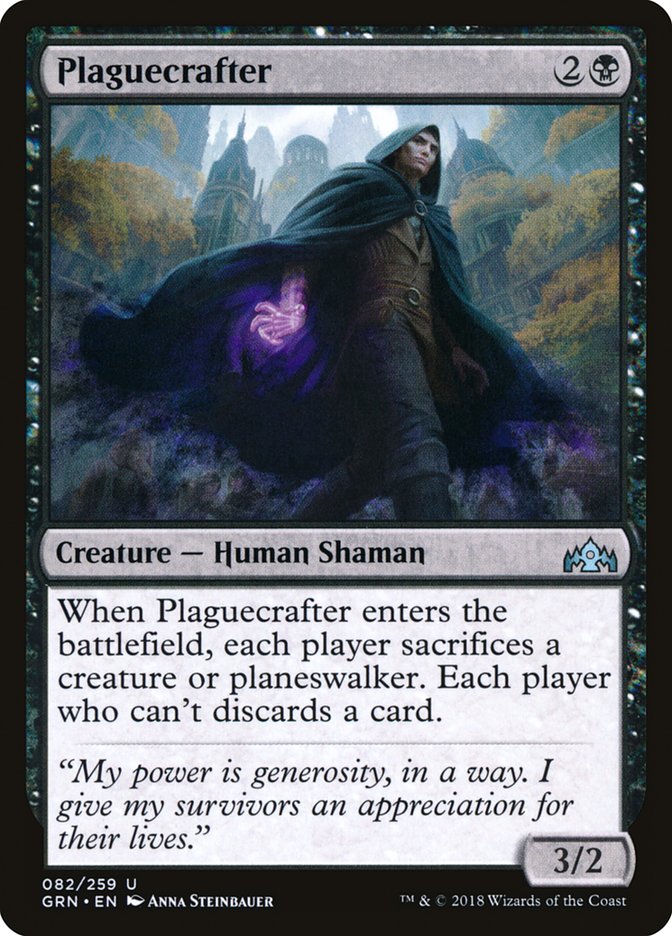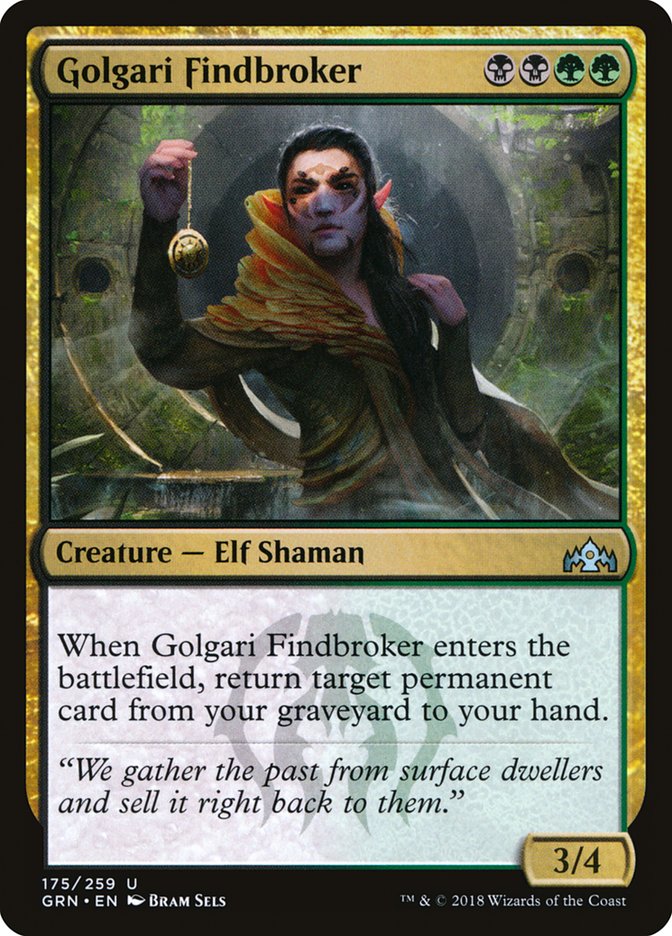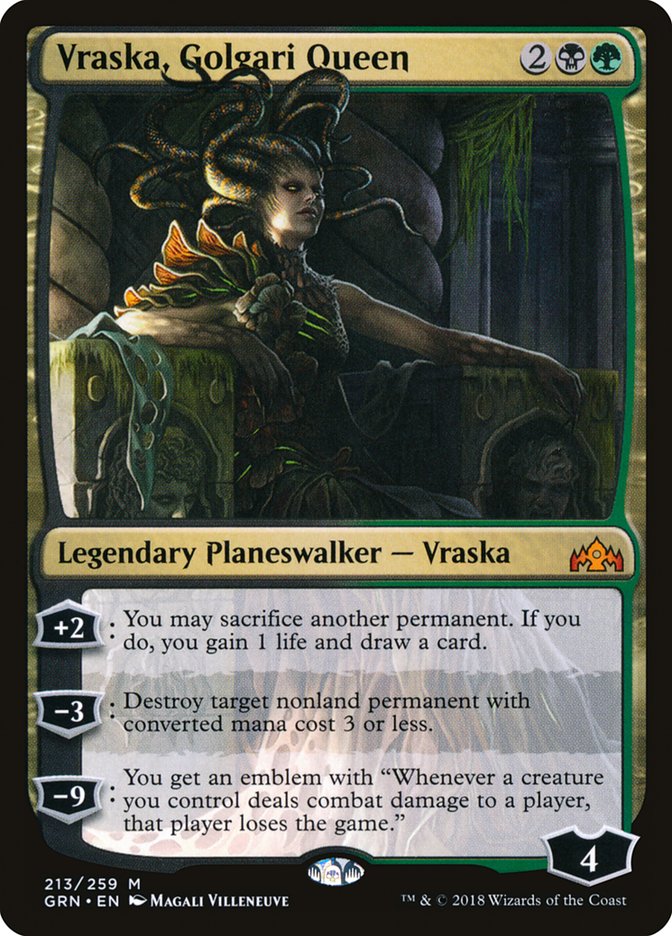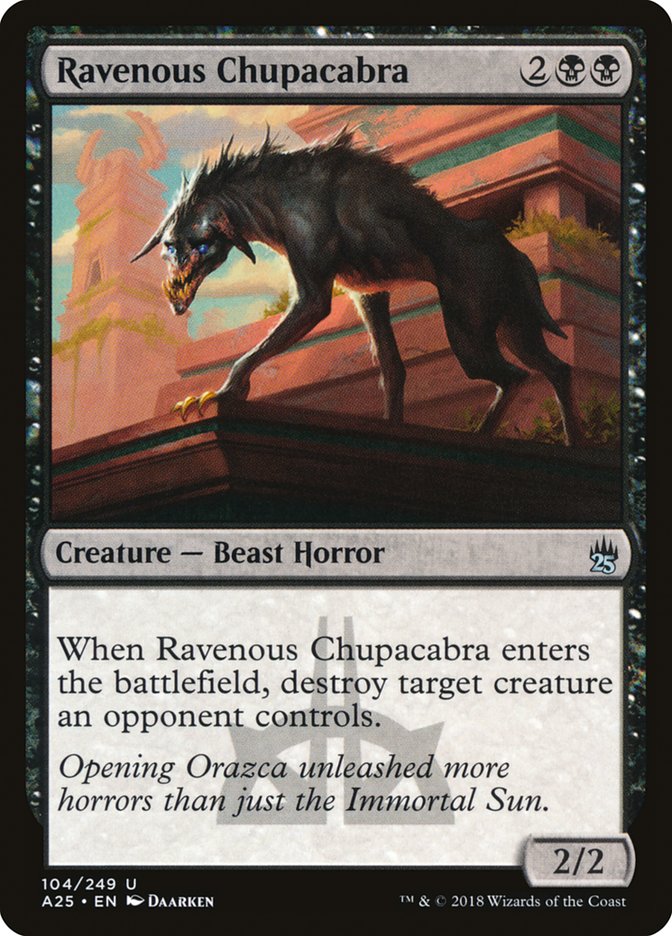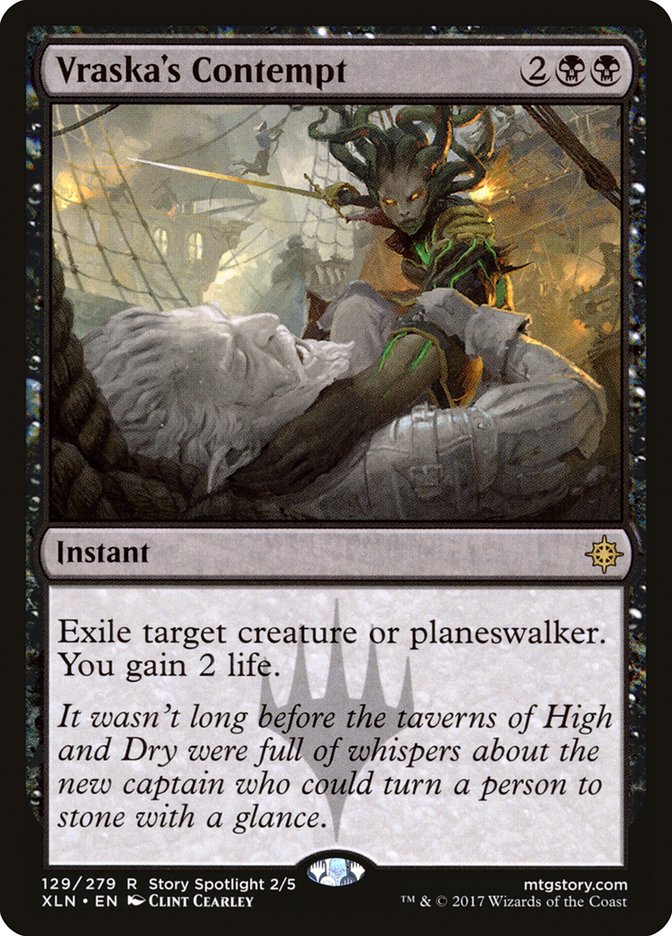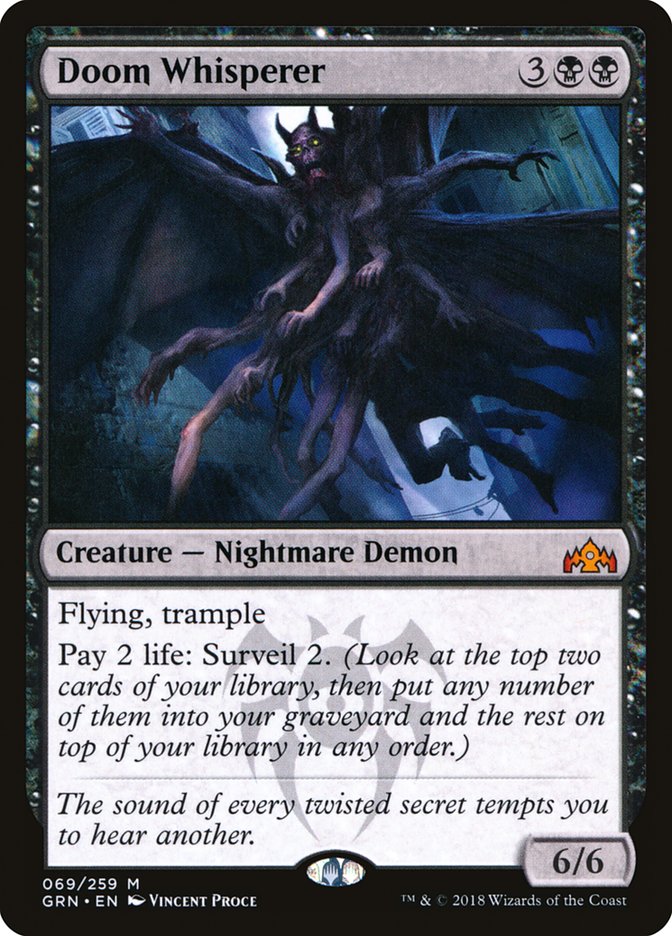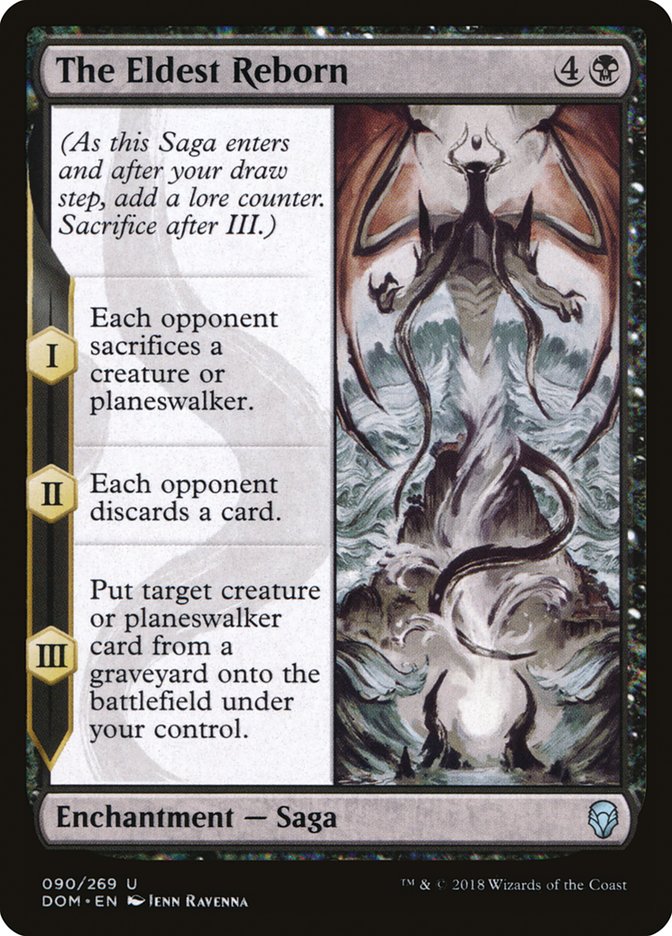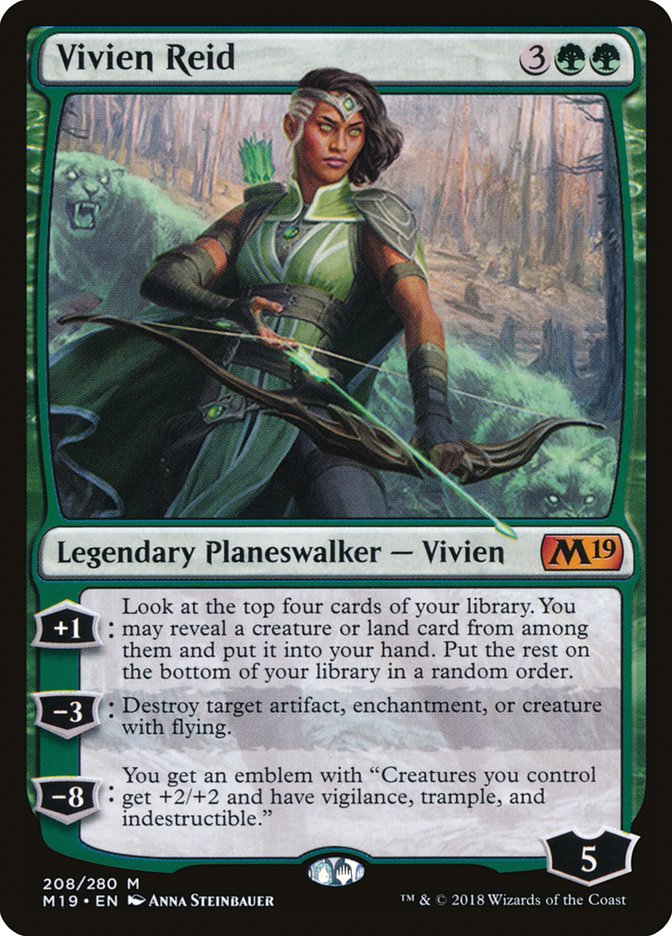I’m lost.
I’ve spent the better part of a week trying to understand the inner
workings of the Golgari Swarm, but only more questions emerged with every
new variation tested. There’s just so many options and too many differing
lists! Articles and social media entries don’t help either as it seems like
everyone shares in my inability to crack this Golgari code whether they’re
able to admit it or not. Some people are amped about certain cards, some
like specific synergies, but collectively there’s limited answers to what
the best version of the deck is. I tried my hardest to have it all figured
out by today, but I do at least have a ton of information I’ve learned
about all the cards that can be played in the archetype.
SCG’s own Abraham Stein
wrote about Golgari decks
as well yesterday so if you haven’t seen that yet I suggest doing so before
continuing with this article.
The Golgari Spectrum
Golgari is a unique guild designed around card advantage. Some of it puts
cards into your hand, while others remove permanents from the battlefield,
but in the end it’s all about value. Since that’s the case, there’s many
different approaches of the deck running around. Some rely heavily on the
graveyard, utilizing cards like Gruesome Menagerie, Golgari Findbroker,
Molderhulk, and Find, while others are more similar to generic midrange
decks casting Planeswalkers and killing creatures.
Creatures (30)
- 4 Llanowar Elves
- 4 Wildgrowth Walker
- 3 Merfolk Branchwalker
- 4 Seekers' Squire
- 4 Jadelight Ranger
- 1 Ravenous Chupacabra
- 1 Plague Mare
- 2 Izoni, Thousand-Eyed
- 1 Molderhulk
- 2 Doom Whisperer
- 4 Plaguecrafter
Lands (23)
Spells (7)

Creatures (30)
- 4 Merfolk Branchwalker
- 1 Seekers' Squire
- 1 Thrashing Brontodon
- 4 Jadelight Ranger
- 3 Ravenous Chupacabra
- 4 Stitcher's Supplier
- 2 Izoni, Thousand-Eyed
- 4 Molderhulk
- 2 Golgari Findbroker
- 3 Glowspore Shaman
- 2 Plaguecrafter
Lands (24)
Spells (6)

Creatures (21)
- 4 Llanowar Elves
- 4 Merfolk Branchwalker
- 4 Jadelight Ranger
- 3 Ravenous Chupacabra
- 1 District Guide
- 3 Golgari Findbroker
- 2 Plaguecrafter
Planeswalkers (7)
Lands (24)
Spells (8)

There’s pros and cons to each variation, but with that in mind, I’m still
not sure there’s a place in the metagame for them all. Without knowing yet
which one is better than the others, I’ve started to lean more on figuring
out which cards belong in which versions, as there’s a lot of overlap
between all the variations.
The first place this takes us is debating between which three-mana creature
we want to play.
It’s difficult to think an uncommon could be better than a rare when the
cards do similar effects, but I’m starting to realize that Jadelight Ranger
is only strictly better than District Guide in decks wanting to abuse
explore synergies. This mostly just includes decks wanting to abuse
Gruesome Menagerie, but again, the decks using this card are revolving
around Wildgrowth Walker. There’s a world where a deck wants Gruesome
Menagerie without playing the explore package but for now I’m uncertain if
that strategy exists.
I’ve found District Guide to be the superior choice in variants that omit
Gruesome Menagerie and Llanowar Elves from the strategy. It’s just so vital
to get to four mana in these builds as Ravenous Chupacabra, Vraska, Golgari
Queen, Golgari Findbroker, and Vraska’s Contempt rely on being cast on time
to inflict maximum damage. The mana is also not good enough to consistently
have two green sources by turn three and then two black sources on turn
four. District Guide helps smooth out both color issues while also helping
make land drops. This is also a format where creatures die often, making
the size difference negligible in most situations. If a Golgari deck needs
to make every land drop, District Guide is what it’s looking for.
This creates a conflict with sideboards, though, as many versions of
Golgari have been sideboarding Wildgrowth Walker as their anti-red card.
While this can be effective in lists that play 8-12 explore creatures, I
feel it’s simply a rudimentary way to build decks right after a set
releases. In Golgari decks that don’t focus on Gruesome Menagerie, I’ve
realized I don’t want to lean on explore at all. Instead I’ve really liked
this card as my anti-red strategy.
Anyone who knows me can tell you that I put Deathgorge Scavenger into too
many decks and have done so since Ixalan was first released. I
just love this little dino, but my bias towards great cards shouldn’t
diminish the fact that Deathgorge Scavenger is a good card. Maybe not a
great one but good enough to be a part of certain Golgari decks as it does
so many unique things.
For starters, it’s a three-drop that gains life against Mono-Red Aggro, a
strategy that commonly kills the first couple creatures placed onto the
battlefield anyway. A high density of them alongside Find suddenly gives
you a rather potent plan against red decks. It’s also a decent card in
certain Golgari mirrors, as it can remove specific cards in the graveyard
that most likely won’t stay there for very long.
Say buh bye, Izoni!
Lastly, it’s not the worst threat to play against control decks as it hits
just hard enough while also being a great way to meddle with Search for
Azcanta and Chemister’s Insight. Forcing the decision of casting Settle the
Wreckage or jump-starting Chemister’s Insight is exactly the situation you
want to put control into. There aren’t many cards that can be brought in
against so many different strategies, but Deathgorge Scavenger is one of
them which is why I love it so much!
So, to clear things up, as this conversation can get quite convoluted,
we’re going to say for now that two of the three ways to build Golgari are
set in stone: Golgari Menagerie and Golgari Planeswalkers. Golgari
Menagerie is any version of the deck that wants to pair Gruesome Menagerie
with explore creatures and Golgari Planeswalkers is builds similar to
Yamakiller’s PTQ winning list. The third variation involves any build that
doesn’t want to play either Llanowar Elves or Gruesome Menagerie. This is
the version that creates the most confusion when trying to understand how
to build it because the options are much more wide-open.

That’s just the two-drop creatures we could play and doesn’t even account
for noncreature two-drops like Cast Down, Assassin’s Trophy, or Arguel’s
Blood Fast! What are we supposed choose when there’s people out there
playing different combinations of all these cards? Is there a correct
mixture that we’ll eventually all settle on or is there more to this topic
than is currently being discussed?
There are a few ways to go about trying to figure this out. We can start
the conversation off by first figuring out what we want our deck to
accomplish. For example, let’s say we want to maindeck Ritual of Soot (we
decided to maindeck it ourselves, and not because the Golgari God Wily Edel
told us too but because we can make our own decisions):
This Damnation wannabee is a great way for Golgari decks to have access to
a reset button when the battlefield gets too troubling. Bigger threats can
easily be dealt with by Ravenous Chupacabra or Assassin’s Trophy, but
occasionally a swarm can get out of hand, especially when History of
Benalia is involved.
If Ritual of Soot is something you’re interested in, playing creatures that
have value while they’re on the battlefield might not be what you’re
looking for. Dryad Greenskeeper wants to stay on the battlefield for as
long as possible so playing it alongside sweepers doesn’t really make much
sense. Instead, cards like Dusk Legion Zealot and Burglar Rat start to look
pretty good if we plan to sweep them up eventually anyway. The same can be
said if we’re wanting to play a high density of Plaguecrafters.
Another way to dissect this problem is pairing the creatures together if
synergies can be found. It’s important to consider this since such a high
density of two-drop creatures means we’ll be deploying them throughout the
entire game. Glowspore Shaman might look like a great way to fuel the
graveyard while also making sure a third landrop can be found, but it also
combos well with other two-drops that can be played. Dryad Greenseeker,
Merfolk Branchwalker, and Seeker Squire all can check the top of the
library for a land and if it’s there, it goes to your hand. Glowspore
Shaman puts a land on top of your deck! Synergy! Again though, you wouldn’t
want to pair Dryad Greenseeker with Ritual of Soot as this creature likes
to stay in on the battlefield as long as possible to generate as much value
as possible.
The last way to decide which two-drops we want to play involves
understanding the metagame. Nine times out of ten, Dusk Legion Zealot will
be better than Seeker Squire against decks like Selesnya Tokens or control
decks, but against Mono-Red Aggro there’s a high likelihood that Seeker
Squire is the stronger choice for a variety of reasons. If the format moves
towards everyone trying to play more grindy strategies, Dryad Greenseeker
might just be the best thing we could be doing. For now, we must use more
abstract judgment calls as there’s a plethora of different strategies being
played, but eventually this discussion may have clear frontrunners for us
to pick.
Moving forward, we have the three-drops…
We’ve discussed three of these cards already, so the focus here will be on
Plaguecrafter. I’ve had mixed feelings on this card, as it’s really nice
sometimes but other times it can feel underpowered. For right now I think
Plaguecrafter is much better in Golgari Menagerie but still think it’s
worth having access to in other builds. I just wouldn’t go crazy on it, as
it’s not the most reliable card against Teferi-based control decks since
they can easily hold up Essence Scatter after casting the powerful
Planeswalker.
Having a good turn four is often very important for these builds of Golgari
so it’s vital to have a great mix of spells in this slot. Golgari
Findbroker is an interesting card, as it needs a graveyard to be potent, so
rarely is it an amazing four-drop unless an explore creature put something
into the graveyard or you’ve cast Dead Weight and want to bring it back.
Later in the game, Golgari Findbroker is amazing, but the deck has to
almost be built around the card to justify more than playing one or two
copies.
I’ve done a complete 180 on Vraska, Golgari Queen, as I originally thought
she would only function in synergy-based strategies. I was so wrong! This
card is just a good Magic card and does many things a deck like Golgari
wants to happen. Sometimes it will take care of a pesky creature right when
it enters the battlefield but later in the game this deck runs into the
issue of having access to an abundance of useless lands which Vraska,
Golgari Queen can recycle into new cards.
Ravenous Chupacabra is the truth, but I keep going back and forth between
wanting three or four copies. The card just does it all for a deck like
this, as it’s a way to keep the battlefield manageable but also provide a
body for future engagements. Patrick Sullivan was certainly right about
this card, but he was a little early to the party. Now that Vehicles and
Scrapheap Scrounger are gone, Ravenous Chupacabra is doing some serious
work on the format’s best threats.
Vraska’s Contempt is in a unique spot right now in Golgari decks, as it
competes with Ravenous Chupacabra when it comes to killing creatures. Both
are rather expensive, but one synergizes with the Golgari theme of
recurring creatures while the other doesn’t. Golgari doesn’t even have to
lean on this card to defeat Planeswalkers anymore as the deck now has
access to Assassin’s Trophy, Plaguecrafter, and The Eldest Reborn to help
keep these pesky permanent-type off the battlefield.
I don’t think Doom Whisperer is a powerful card for Golgari decks. It might
be good elsewhere, but it’s just not what I want my Golgari decks to be
focused on. I want to gain advantages with cheaper cards while slowly and
meticulously taking over a game of Magic. Doom Whisperer is mostly just the
beatstick other strategies might want, but it doesn’t have a home here as
the rest of the cards in the deck don’t have the same motivations, causing
this card to look out of place in most games.
The synergy between The Eldest Reborn and Golgari Findbroker is absolutely
filthy, but as of right now I believe this one to be best used alongside
Llanowar Elves as ramping into it can make it much more potent. Golgari
decks that don’t want to ramp will often find the need to be more precise
in the way they interact on turn 5. That’s not to say this can’t be in the
sideboard of Golgari decks omitting Llanowar Elves, but it just doesn’t
feel as good without them.
Another good interaction with Llanowar Elves. There’s also a ton of fliers,
enchantments, and artifacts running around that Vivien Reid can get off the
battlefield. I’ll be surprised if this card doesn’t see a decent amount of
play in this format even if it’s just in every green deck’s sideboard.
I’m not even going to bother talking about this card out of the context of
a specific decklist, as Bryan Gottlieb
wrote an entire article
about this card just yesterday. If you haven’t read that, do yourself a
favor and get over there right now. I’ll still be here for when you return.
I didn’t know what to make of Izoni the first time I saw it, but part of me
thought it had potential. Well, I was right! Izoni is a great finisher for
any Golgari deck wanting to play a slow grindy game. If you’re not playing
a version similar to Yamakiller’s, I highly suggest playing Izoni but I’m
pretty sure everyone already knows this.
Big Vraska did, in fact, get much stronger after rotation and has played an
important role in every version of Golgari that doesn’t play Gruesome
Menagerie. Don’t sleep on this card and don’t justify not playing it for
some random reason. It’s a nice curve topper for turn six when you’ve
slowly found your way there.
I threw a lot of these opinions into a big pot, sprinkled in some very
informative conversation with Willy Edel, and came out with this build of
Golgari.
Creatures (24)
- 4 Merfolk Branchwalker
- 2 Deathgorge Scavenger
- 4 Seekers' Squire
- 4 Ravenous Chupacabra
- 2 Izoni, Thousand-Eyed
- 4 District Guide
- 2 Golgari Findbroker
- 2 Plaguecrafter
Planeswalkers (4)
Lands (23)
Spells (9)

Props for this list must go to Willy Edel, as he’s been a great resource to
us even though his decklists are sometimes frustrating to decipher…
My current list for the PT. Let’s see how many cards
change in one month:3 volrath stronghold 19 other
lands
2 push 2 maelstron pulse 2 languish
2 chandra 2
profane command 2 vraska
10 visionary 5 rogue refiner 2
witness
3 liliana 4 nekrataal 2 decree of
justice— Willy Edel (@bazardebagda) October
8, 2018
I’m still unsure about playing Dusk Legion Zealot or Seekers’ Squire, but
there’s been enough Mono-Red Aggro floating around for me to stick with
Seekers’ Squire. Dusk Legion Zealot is the more powerful card against the
rest of the metagame though, so it might just be worth the slot. I’d want
to change around a few things about the deck, as my list would most likely
want another cheap removal spell and the fourth Deathgorge Scavenger to
make up for having the inferior two-drop for that matchup. Who am I kidding
though – I still don’t have the slightest clue about how to build the best
Golgari deck.
You wanna know a secret?
Neither does anyone else and they are lying to themselves if they say
they’ve figured it out.


